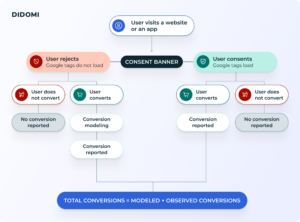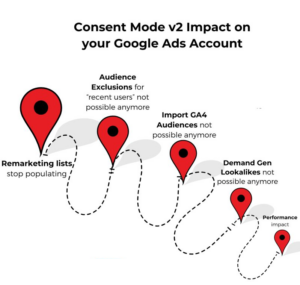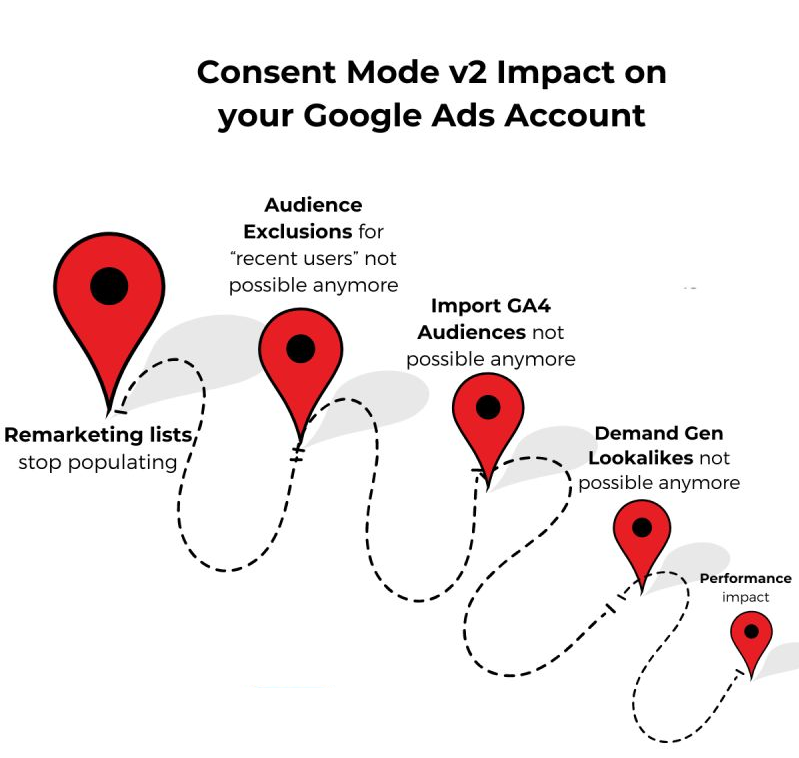In this article, you will learn everything you need to know about what is Google Consent Mode V2 and how does cookie implementation affect advertisers.
What is Google Consent Mode?
At its core, Google Consent Mode is a method that lets you adapt the behavior of Google tags (Analytics, Ads, etc.) based on the consent choices a user makes on your website.
Think of it as the bridge between your cookie banner widget and how Google leverages user data based on their choice. Google defines it as such :
“Consent mode receives your users’ consent choices from your cookie banner or widget and dynamically adapts the behavior of Analytics, Ads, and third-party tags that create or read cookies.”
Why the Change to Consent Mode V2?
In the realm of online advertising and data privacy, Google’s handling of data has been criticized – notably by regulators within the European Economic Area (GDPR) and now recently American regulations (California & Canada’s Quebec Law 25).
Google introduced its Google Consent Mode (i.e. in its first version) in 2020. The evolution to Consent Mode V2 underscores Google’s intent to a privacy-compliant digital ecosystem. Consent Mode V2 introduces more granular controls for how user data can be used, with specific parameters for advertising personalization and remarketing. This infographic shows the process happening and why we recommend going the Advanced V2 mode.

With the looming deadline of March 24, 2024, a significant upgrade – Consent Mode V2 – is set to take effect, carrying costly implications for you as an advertiser. You risk that Google will not be able to extrapolate its non-identifiable pings.
The Clock is Ticking: Understanding Google Consent Mode V2 and the March 2024 Deadline
If you haven’t implemented Consent Mode V2 by the deadline, the consequences for your marketing efforts could be significant:
- Limited Data Collection: You will lose access to valuable insights into website behavior and campaign performance.
- Reduced Ad Effectiveness: Without enabling consent, your ability to deliver targeting will be severely hampered (see infographic below)
- Potential Non-Compliance: Failure to meet the requirements could expose your business to potential regulatory risks.

credit: Thomas Eccel
“I Am Not In Europe, What About USA, Canada And Rest Of World”?
While Google Consent Mode v2 is becoming mandatory for websites targeting the European Economic Area (EEA) and the United Kingdom, it’s not strictly required as of March 24 for websites focusing solely on the American market. However, here’s why you might want to consider implementing it anyway:
- Future-proofing:
- Canadian privacy regulations are evolving, and there’s a possibility that stricter consent requirements similar to those in the EU might be adopted in the future. Implementing Consent Mode v2 proactively would position you well for potential regulatory changes.
- User Privacy & Trust:
- Even if not legally mandated, respecting user privacy is essential. Consent Mode v2 offers enhanced transparency and control over how data is collected and used, ultimately building trust with your Canadian audience.
- Potential Indirect Impacts:
- Some of your Canadian visitors may also be from the EEA or have traveled there recently. Google Consent Mode would help maintain a consistent and compliant experience for them.
- Many large-scale advertising platforms and analytics tools work across markets, and could be impacted by future Consent Mode v2 requirements in other regions.
Why Compliance is Crucial
Beyond merely avoiding penalties, embracing Consent Mode V2 demonstrates a proactive stance towards data privacy.
Here’s why it matters:
- Brand Trust: By respecting user choices, you foster trust and transparency, critical factors in building a positive brand reputation.
- User Experience: Consent Mode V2 allows for a privacy-aware user experience, this is important in many industries or region-specific regulations.
- Competitive Advantage: In an increasingly privacy-conscious world, businesses prioritizing data protection can gain an edge.
Next steps for your implementation
- Collaborate with Your agency : whatever cookie mechanism you use, your agency will ensure a smooth transition to Consent Mode V2.
- Update Your Code: If you manage your consent mechanism manually, you’ll need to update your website code by implementing the new consent parameters.
- Consult Google’s Documentation: Google offers extensive resources to help you navigate the technical aspects of the implementation: https://developers.google.com/tag-platform/security/guides/consent?consentmode=advanced.
Does Shopify support Google Consent Mode v2?

The “official” Customer Privacy Banner (
https://apps.shopify.com/customer-privacy-banner) does not handle Google Consent Mode v2 at the moment. There are apps that allow Google Consent Mode v2 to operate (see below). Shopify does however offer a native API for its storefront ; and some themes support it. Here are a few resources that you might want to consider :
Please note any app still requires you to offload your scripts and make sure Google Consent Mode v2 is enabled, its not out of the box. You still need an expert / agency to handle this.
The Takeaway – Take Action Today
Google Consent Mode V2 represents a critical moment in the evolution of data privacy and digital advertising. It is expected that other platforms such as Facebook (META) and Microsoft will soon follow.
This change shouldn’t be seen as an obstacle but as an opportunity to rebuild the bridge of trust between users and advertisers. By understanding the implications and complying proactively, you can future-proof your advertising strategy and stay ahead in a privacy-focused landscape.
Ready to implement Google Consent Mode V2? Contact Index Agency today and start your journey towards
compliance and user-centric advertising. Remember,
it’s not just about following the rules, it’s about leading the way in your organization!


 The “official” Customer Privacy Banner (https://apps.shopify.com/customer-privacy-banner) does not handle Google Consent Mode v2 at the moment. There are apps that allow Google Consent Mode v2 to operate (see below). Shopify does however offer a native API for its storefront ; and some themes support it. Here are a few resources that you might want to consider :
The “official” Customer Privacy Banner (https://apps.shopify.com/customer-privacy-banner) does not handle Google Consent Mode v2 at the moment. There are apps that allow Google Consent Mode v2 to operate (see below). Shopify does however offer a native API for its storefront ; and some themes support it. Here are a few resources that you might want to consider :